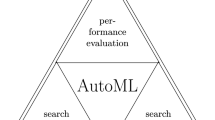Abstract
This paper investigates the possibility of improving the classification capability of single-layer and multilayer perceptrons by incorporating additional output layers. This Multi-Output-Layer Perceptron (MOLP) is a new type of constructive network, though the emphasis is on improving pattern separability rather than network efficiency. The MOLP is trained using the standard back-propagation (BP) algorithm. The studies are concentrated on realizations of arbitrary functions which map from an x-dimensional input MOLP, all problems existing in an original n-dimensional space in the hidden layer are transformed to a higher (n +1)-dimensional space, so that the possibility of linear separability is increased. Experimental investigations show that the classification ability of the MOLP is superior to that of an equivalent MLP. In general, this performance increase can be achieved with shorter training times and simpler network architectures.
Similar content being viewed by others
References
Lippmann RP. An Introduction to Computing with Neural Nets. IEEE ASSP Magazine April 1987; 4: 4–22
Rumelhart DE, Hinton GE, Williams RJ. Learning internal representations by error propagation. In Rumelhart DE, McClelland JL (eds). Parallel Distributed Processing: Explorations in the Microstructure of Cognition, Vol 1: Foundations. MIT Press, 1986
Frean M. The upstart algorithm: a method for constructing and training feedforward neural networks, Neural Computation 1990; 1: 198–209
Fahlman SE, Lebiere C. The cascade-correlation learning architecture. In Touretzky DS (ed) Advances in Neural information Processing Systems 2, Morgen Kaufmann, 1990
Mezard M, Nadal JP. Learning in feedforward layered networks: the tiling algorithm. J Physics A 1989; 22: 2191–2203
Nadal JP. Study of a growth algorithm for a feedforward neural network. Int J Neural Systems 1989; 1: 55–59
Ash T. Dynamic node creation in backpropagation networks. Connection Science 1989; 1(4)
Rosenblatt F. Principles of Neurodynamics. Spartan Books, New York, 1959
Smieja FJ. Neural network constructive algorithms: trading generalization for learning efficiency? Circuits Systems Signal Processing 1993; 12(2): 331–374
Zheng GH, Owens FJ. A multi-layer neural network with a multi-output layer. Proc Int Conf Neural Networks and Signal Processing 1993; 46–50
Tou JT, Gonzalez RC. Pattern Recognition Principles. Addison-Wesley, 1974
Gorman RP, Sejnowski TJ. Analysis of hidden units in a layered network trained to classify sonar targets. Neural Networks 1988; 1: 75–89
Mirchardani G, Cao W. On hidden nodes for neural nets. IEEE Circuits and Systems 1989; 36(5)
Peeling SM, Moore RK. Isolated digit recognition experiments using the multi-layer perceptron. Speech Communication 1988; 7(4): 403–410
Author information
Authors and Affiliations
Rights and permissions
About this article
Cite this article
Owens, F.J., Zheng, G.H. & Irvine, D.A. A Multi-Output-Layer Perceptron. Neural Comput & Applic 4, 10–20 (1996). https://doi.org/10.1007/BF01413865
Issue Date:
DOI: https://doi.org/10.1007/BF01413865




